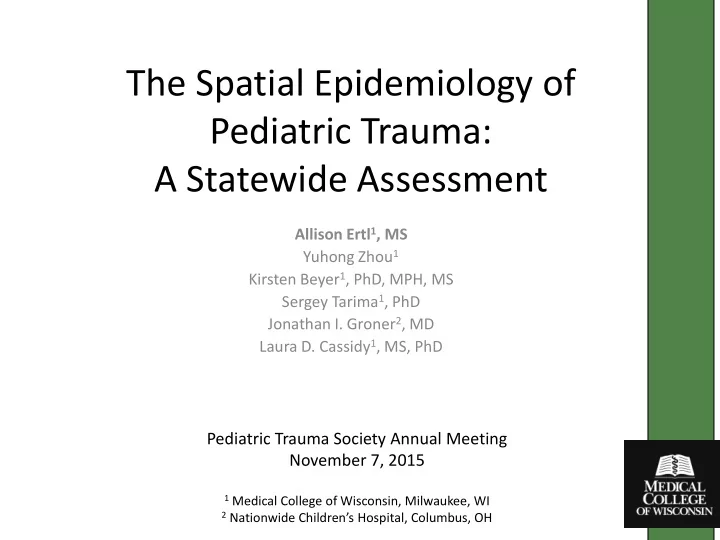

The Spatial Epidemiology of Pediatric Trauma: A Statewide Assessment Allison Ertl 1 , MS Yuhong Zhou 1 Kirsten Beyer 1 , PhD, MPH, MS Sergey Tarima 1 , PhD Jonathan I. Groner 2 , MD Laura D. Cassidy 1 , MS, PhD Pediatric Trauma Society Annual Meeting November 7, 2015 1 Medical College of Wisconsin, Milwaukee, WI 2 Nationwide Children’s Hospital, Columbus, OH
Funding Acknowledgement Research reported in this presentation was supported by the NICHD of the National Institutes of Health under award number 1R03HD071924-01A1, Laura D. Cassidy, PhD Principal Investigator. The content is solely the responsibility of the authors and does not necessarily represent the official views of the National Institutes of Health.
Introduction • Trauma is the leading cause of death in children ages 19 years and younger • Identification of areas with high rates of pediatric trauma needed • Geographic Information Sciences (GIS) can be used for trauma surveillance and spatial organization of trauma data • This study used GIS to analyze statewide data from the Ohio Trauma Registry (OTR) to identify spatial patterns in pediatric injury
Methods • OTR contains 89% of Ohio’s Hospitals • Data on 17,377 pediatric trauma patients under 16 years old from 2007-2012 • Adaptive spatial filtering effectively controls for population size • Age- and sex- adjusted pediatric trauma rates 1. Severe trauma indirect rate (Injury Severity Score (ISS) >15) 2. Standardized Mortality Ratio
RESULTS
Conclusion • Areas with higher than expected age- and sex- adjusted rates of severe injury and mortality, particularly those >1 hour from a PTC or Level I ATC, should be further explored to identify opportunities for injury prevention and appropriate access to timely care.
Questions? alertl@mcw.edu Acknowledgment: The authors would like to acknowledge Timothy Erskine and Schuyler Schmidt of the Ohio Department of Public Safety for providing the data .
Recommend
More recommend